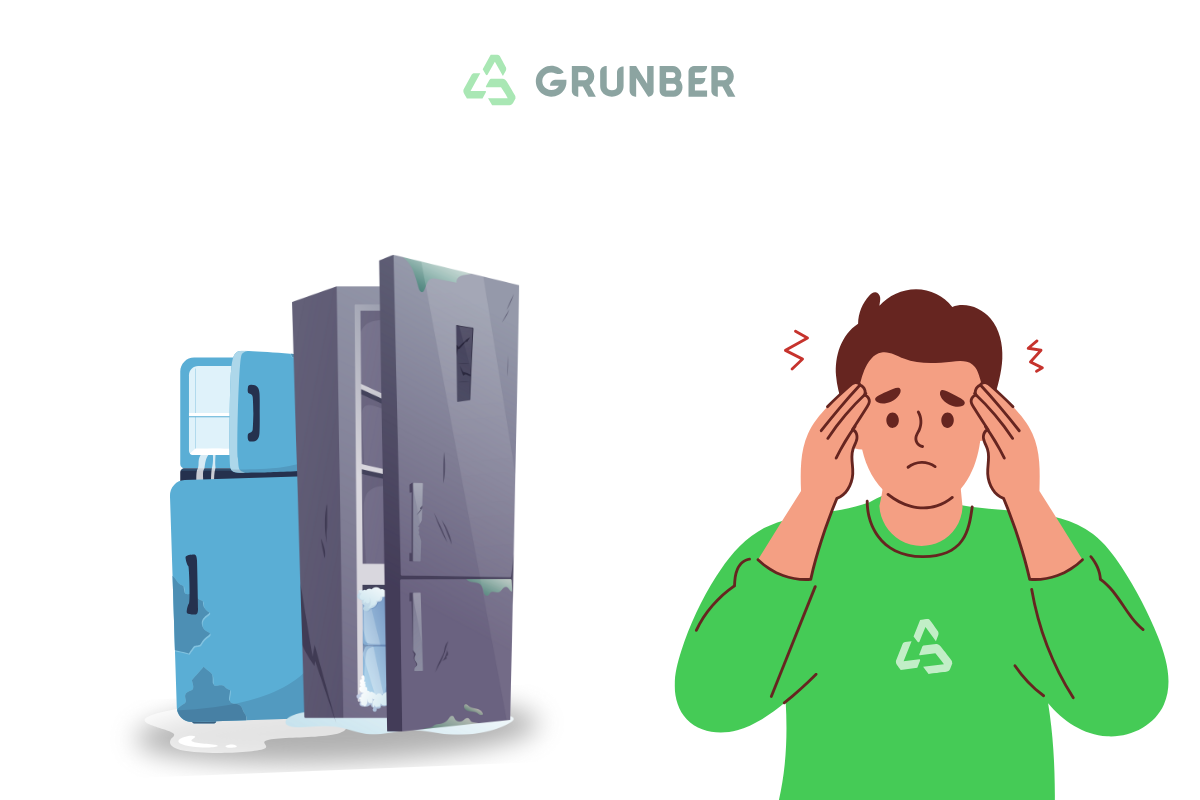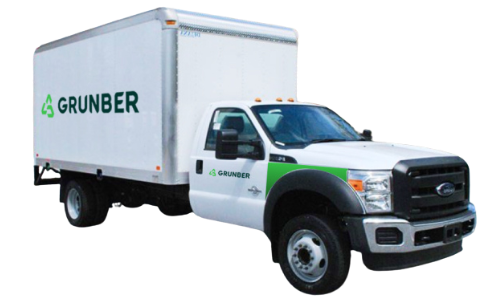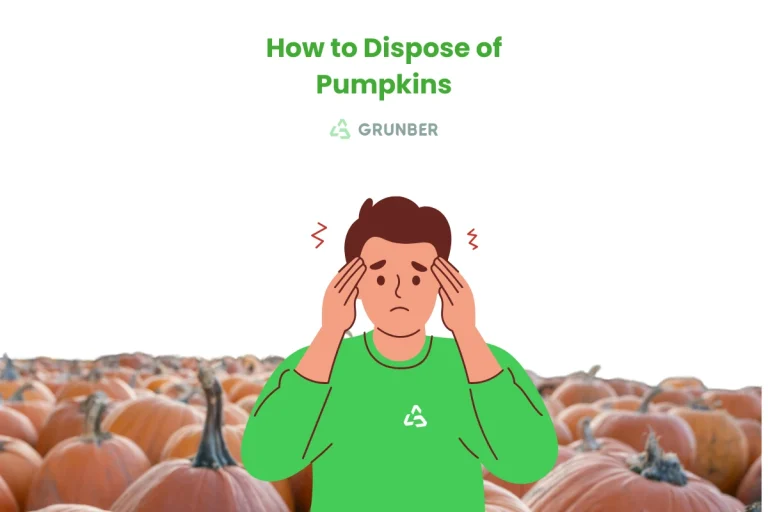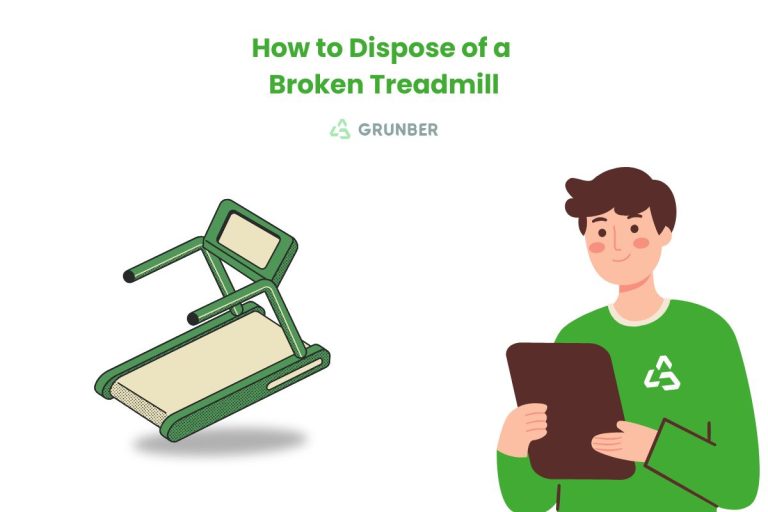The refrigerator is a cornerstone of every home and business, diligently keeping our food fresh and our drinks cold. But what happens when this essential appliance reaches the end of its life, breaks down, or simply becomes outdated? Disposing of an old refrigerator is not as straightforward as tossing out regular trash. These large appliances are heavy, cumbersome, and contain potentially harmful substances that require special handling.
At Grunber, we understand the challenges of appliance disposal. Our mission is to make clearing out clutter both convenient and environmentally responsible. We’ve revolutionized junk removal by connecting you with trusted local drivers across the USA, simplifying the entire process from scheduling to support. If you’re wondering how to properly dispose of a refrigerator, you’ve come to the right place. We’re here to guide you through the process and offer a seamless, eco-conscious solution.
Why Proper Refrigerator Disposal Matters
Before thinking into disposal methods, it’s crucial to understand why old refrigerators demand careful handling. It’s not just about their size; it’s about what’s inside them.
Environmental Impact:
- Refrigerants: Older refrigerators and freezers, particularly those manufactured before 1995, often contain chlorofluorocarbons (CFCs) or hydrochlorofluorocarbons (HCFCs). These are potent ozone-depleting substances (ODS) and greenhouse gases that significantly contribute to the destruction of the ozone layer and global climate change if released into the atmosphere. Even newer units (post-1995) containing hydrofluorocarbons (HFCs) are still greenhouse gases and must be handled carefully. Federal law mandates the removal and recovery of these refrigerants.
- Foam Insulation: Refrigerators and freezers produced before 2005 contain foam insulation with ODS that also contribute to ozone depletion and climate change. If not properly managed, the blowing agents in this foam insulation can be emitted during shredding or landfilling. While not always regulated, some recycling programs aim to capture foam insulation for added environmental benefits. For other materials that require specific disposal methods, such as Styrofoam [internal link to How to Get Rid of Styrofoam Safely], proper recycling is key to minimizing environmental impact.
- Hazardous Components: Appliances may contain other dangerous elements like used oil (which can be contaminated with ODS refrigerant), mercury (in switches and relays of some units pre-2000), and polychlorinated biphenyls (PCBs) (in capacitors of units pre-1979). These substances pose risks of groundwater contamination and serious health issues if improperly released.
Safety Hazards:
- Entrapment Risk: The Refrigerator Safety Act prohibits discarding a refrigerator without first removing its doors. This is a critical safety precaution to prevent young children or animals from becoming trapped inside.
- Physical Harm: Refrigerators are incredibly heavy and awkward to move, posing a risk of injury if not handled by multiple people or with proper equipment. Attempting to remove refrigerants or compressors yourself is dangerous and can result in physical harm.
Given these concerns, it’s clear that responsible disposal isn’t just a recommendation—it’s a necessity for environmental protection and public safety.
Your Options for Refrigerator Disposal
Knowing your options is the first step toward responsible disposal. Here’s a comprehensive look at how to get rid of your old refrigerator:
1. Selling, Donating, or Upcycling (If Functional)
If your refrigerator is still in good working order, don’t just throw it away! Giving it a second life is the most eco-friendly option.
- Sell It Online: Platforms like eBay, OfferUp, Craigslist, or Facebook Marketplace are great avenues for selling functional appliances. To make your listing successful, research current prices for similar models, provide accurate measurements (height, width, depth), include clear, well-lit pictures from all angles (inside and out), and be honest about any blemishes. Highlight key features like adjustable shelves or crisper drawers.
- Donate It: Many local charities and non-profit organizations, such as the Salvation Army, Habitat for Humanity ReStore, Donation Town, or Vietnam Veterans of America, accept working refrigerators. Some may even offer free pickup services, saving you the hassle of transportation. Always call ahead to confirm they accept appliances and check for any age restrictions.
- Upcycling: For the creatively inclined, an old refrigerator can be repurposed into something new, like a bookcase, a pantry, or even a garden planter. More advanced DIYers might convert a mini-fridge into a kegerator or a full-sized fridge into a meat-curing chamber. Note that some of these projects, especially those involving non-functioning fridges, still require the professional removal of refrigerants for safety before you start.
2. Utilizing Municipal or Utility Programs
Many local governments and utility companies offer programs to help residents dispose of appliances.
- Curbside Collection: Your municipal waste management division might offer bulk item pickup for large appliances. However, this service often comes with specific requirements: you’ll likely need to schedule an appointment in advance, and you must remove the doors and have the refrigerant professionally removed before pickup. For instance, New York City’s Department of Sanitation provides free curbside CFC removal for residents by specially-trained staff, who then tag the appliance for later pickup by sanitation workers.
- Electric Company Programs: Many electric utility companies run “bounty programs” or recycling initiatives that offer cash, utility bill credits, or free pickup for old, inefficient refrigerators. These programs encourage the removal of energy-inefficient appliances. Contact your local electric provider to inquire about their specific offerings and any eligibility requirements, such as appliance age or working condition.
3. Professional Junk Removal Services (The Hassle-Free Choice)
For the most convenient and responsible disposal, a professional junk removal service is often the best solution.
- Comprehensive Service: Companies like Grunber handle everything for you. This means no heavy lifting on your part; our trained teams will remove the refrigerator from anywhere in your home or property, sweep up the area, and ensure it’s properly handled.
- Handling All Types of Refrigerators: Whether you have a full-sized combination fridge, a deep freezer, a side-by-side model, or even a mini-fridge, professional junk removal services like Grunber can take them all. These smaller appliances still contain refrigerants and insulation that require careful disposal, just like their larger counterparts.
- Beyond Refrigerators: Professional junk removal services are also ideal for other bulky or difficult-to-dispose-of items that municipal services might not take. For instance, if you’re upgrading your home and need to dispose of an old water heater, these services can provide a comprehensive solution for multiple items, saving you time and effort.
4. Scrap Metal Recyclers
You can sell your old refrigerator to a scrapyard for its metal content. However, this option requires significant preparation:
- Refrigerant Removal: You must first have the refrigerant professionally removed and the lines capped by a licensed repair company. The unit should then be tagged with proper EPA stickers to signify safe removal. Scrapyards typically won’t accept units with refrigerants still intact due to legal and safety issues.
- Transportation: You’ll be responsible for transporting the heavy appliance to the scrapyard yourself.
Essential Preparation Steps Before Disposal
No matter which disposal method you choose, a few crucial steps are required to prepare your refrigerator:
- Unplug and Defrost: Unplug the refrigerator several hours, or even overnight, before moving it to allow the evaporator to defrost completely. Place towels or a pan to catch any melting ice and moisture.
- Clean Thoroughly: Remove all food items, shelves, and drawers. Clean the interior thoroughly to prevent odors or pests.
- Remove or Secure Doors: This is a legal requirement under the Refrigerator Safety Act. Using a socket wrench, Allen wrench, or Phillips screwdriver, carefully remove the hinge brackets and lift the doors off. If you cannot remove the doors, securely tie them shut with rope or tape to prevent accidental entrapment.
- Tape Loose Items: Tape down any remaining loose shelves or compartments inside the fridge to prevent them from shifting or breaking during transport.
- Professional Refrigerant Removal: Unless your chosen disposal service explicitly handles this (like some municipal programs or specialized recyclers), you are legally required to have a certified professional remove the refrigerant. Do NOT attempt this yourself as it is dangerous and requires specialized equipment and training.
Ready for the Easiest Option? Let Grunber Handle It.
You’ve just learned about all the steps, safety rules, and environmental factors involved in refrigerator disposal. It can feel like a lot to manage—from the heavy lifting and finding a certified technician to simply making sure your old appliance ends up in the right place.
At Grunber, we believe you shouldn’t have to become a disposal expert just to clear out some space. Our entire service is designed to take that complexity off your plate.
When you schedule a pickup, our local team handles the entire process. We do the heavy lifting from anywhere in your property, ensure the refrigerator is transported safely, and partner with certified facilities to guarantee it’s recycled responsibly. All hazardous materials are managed according to federal and state regulations, so you don’t have to worry about a thing.
Reclaim your space and get peace of mind knowing you made the right choice for the planet, without the hassle.
Ready to say goodbye to your old refrigerator? Text or call us at (617) 800-6746 for a fast, simple, and eco-friendly solution.











